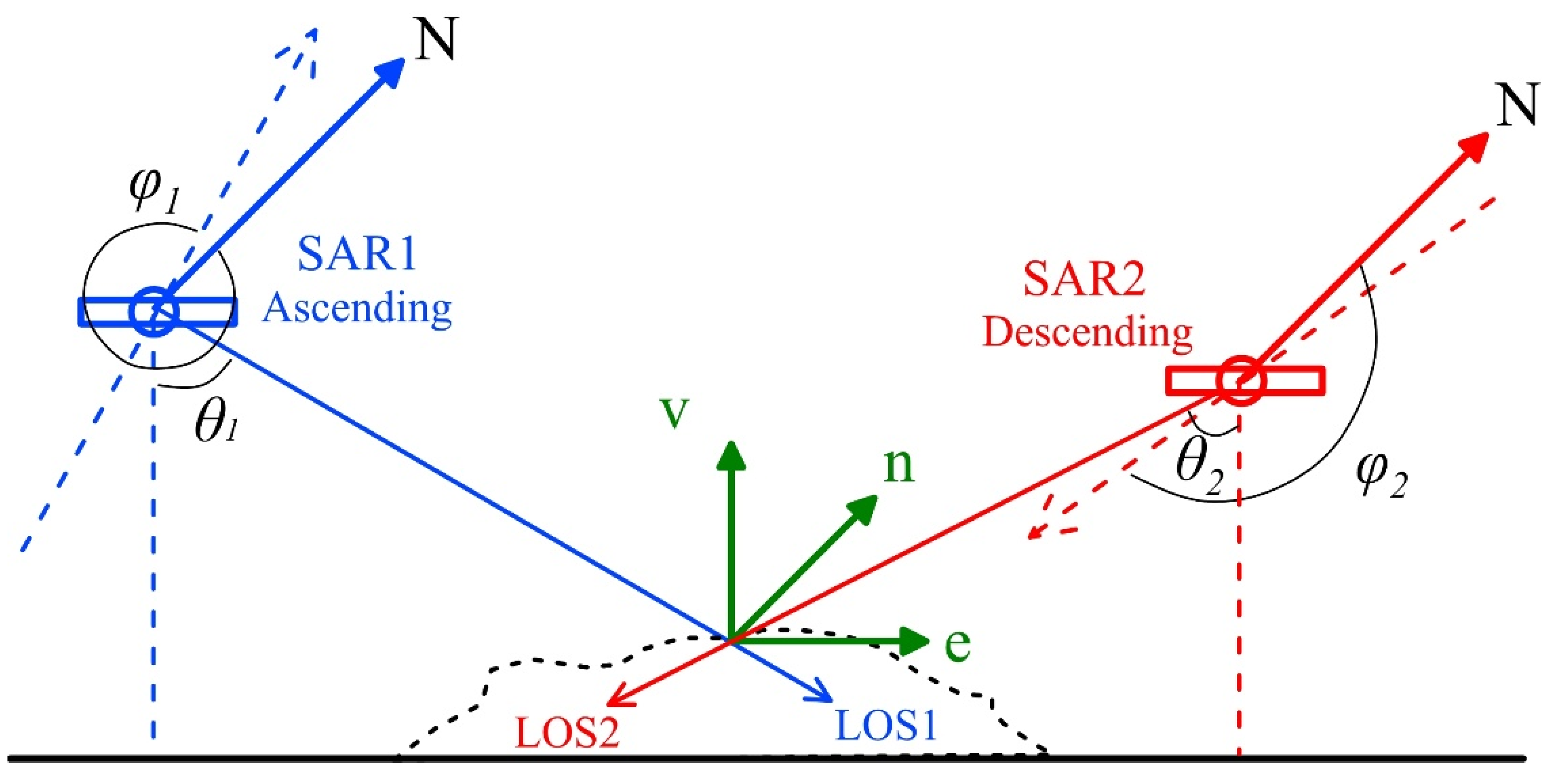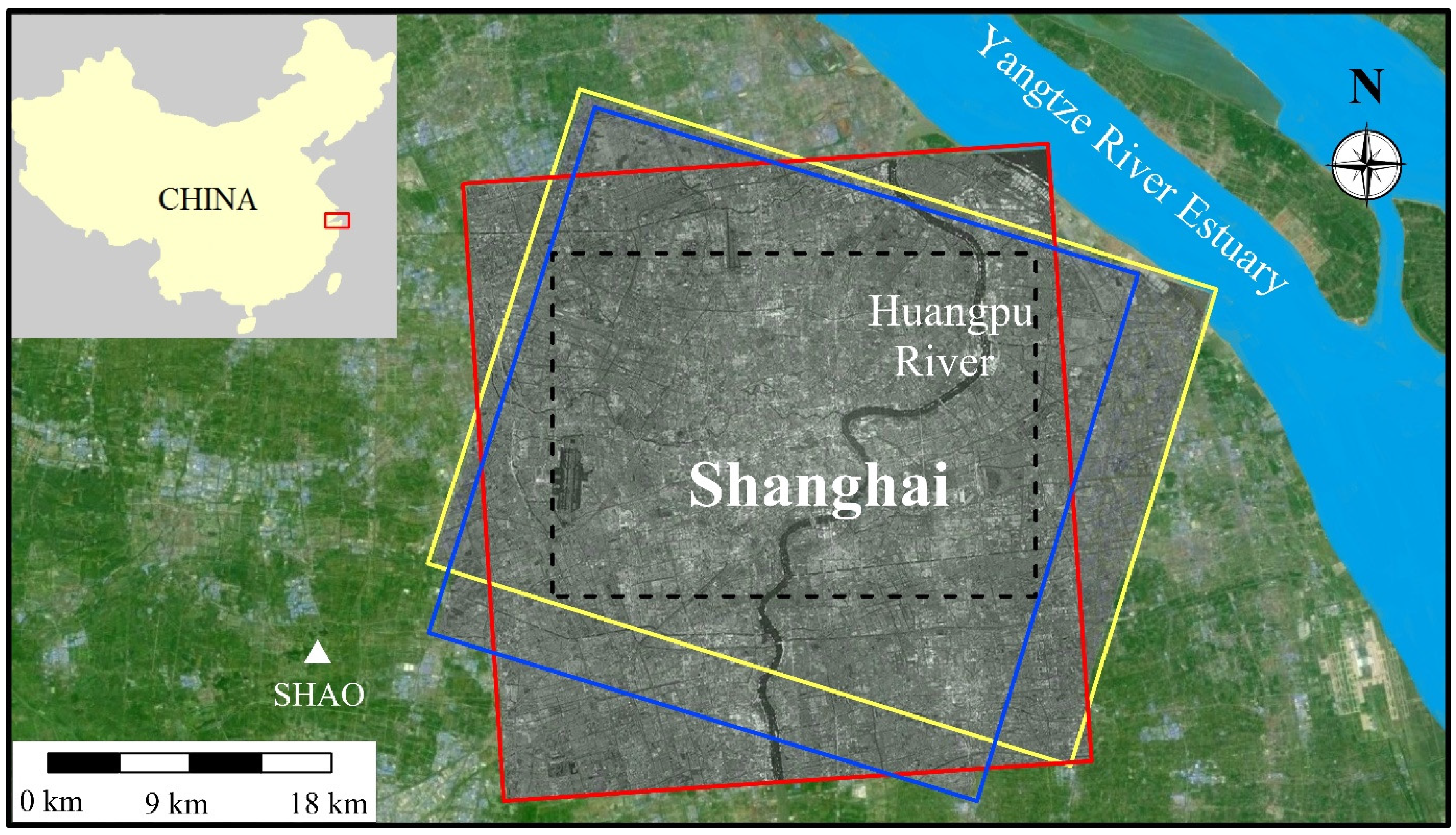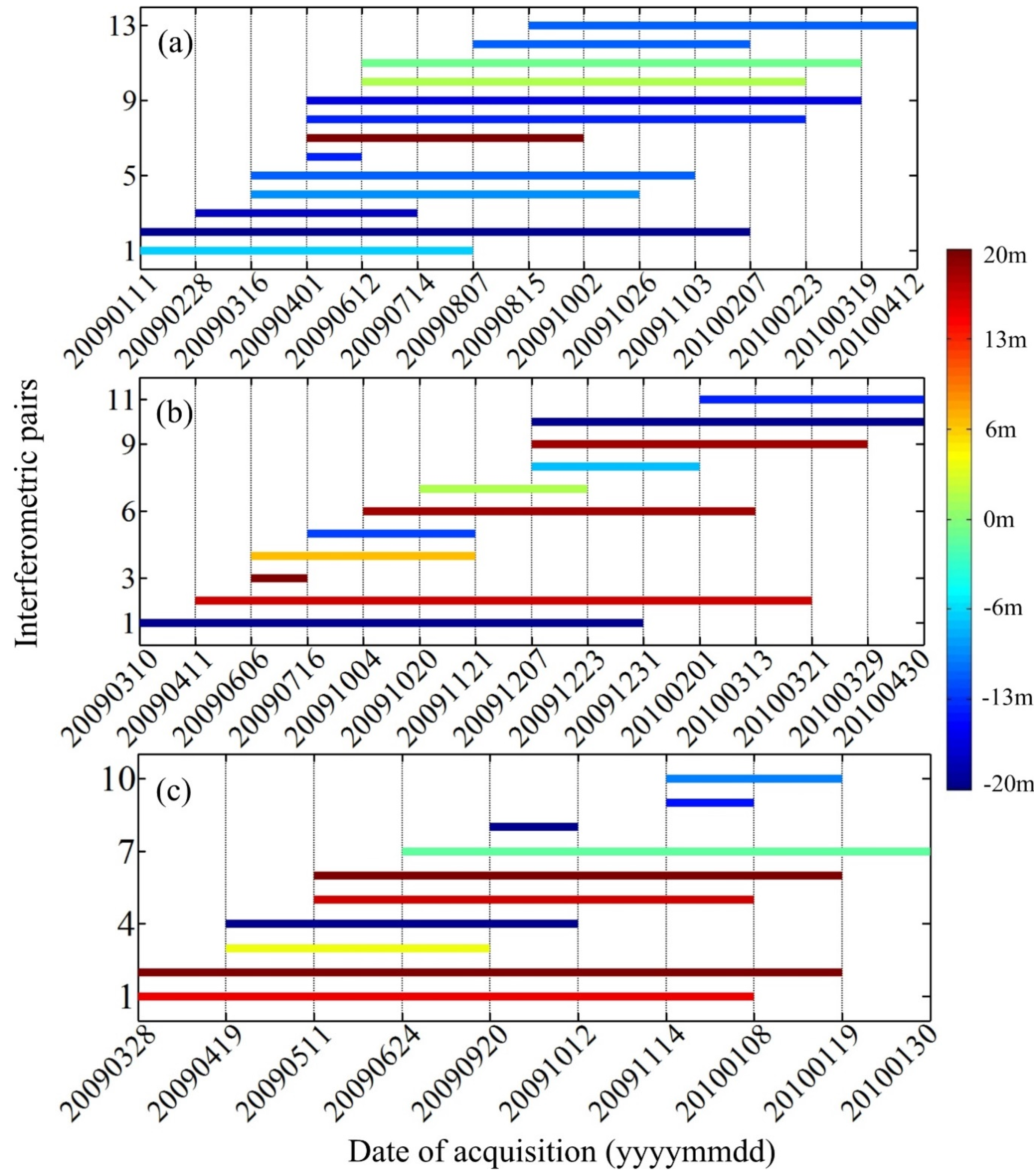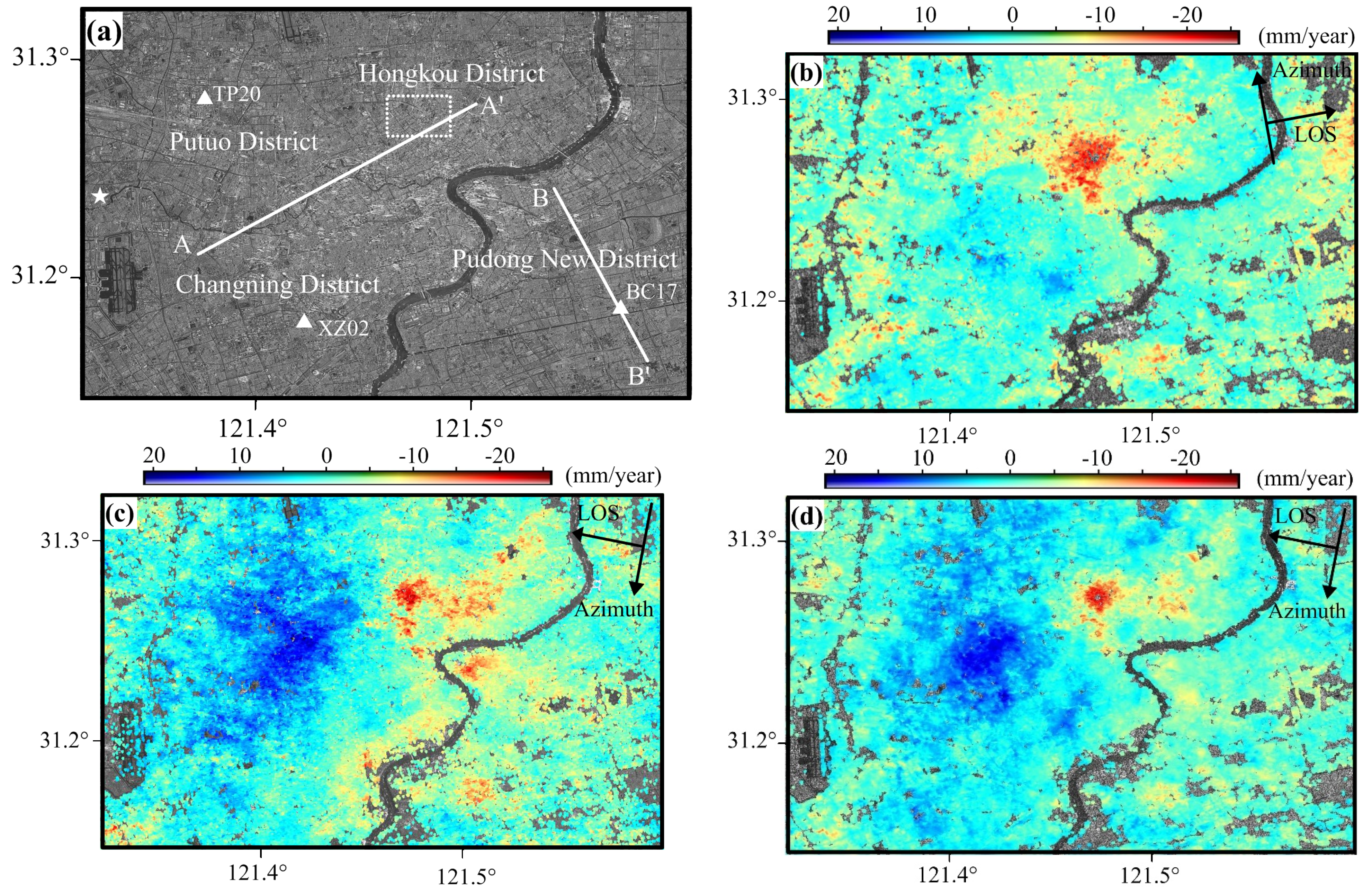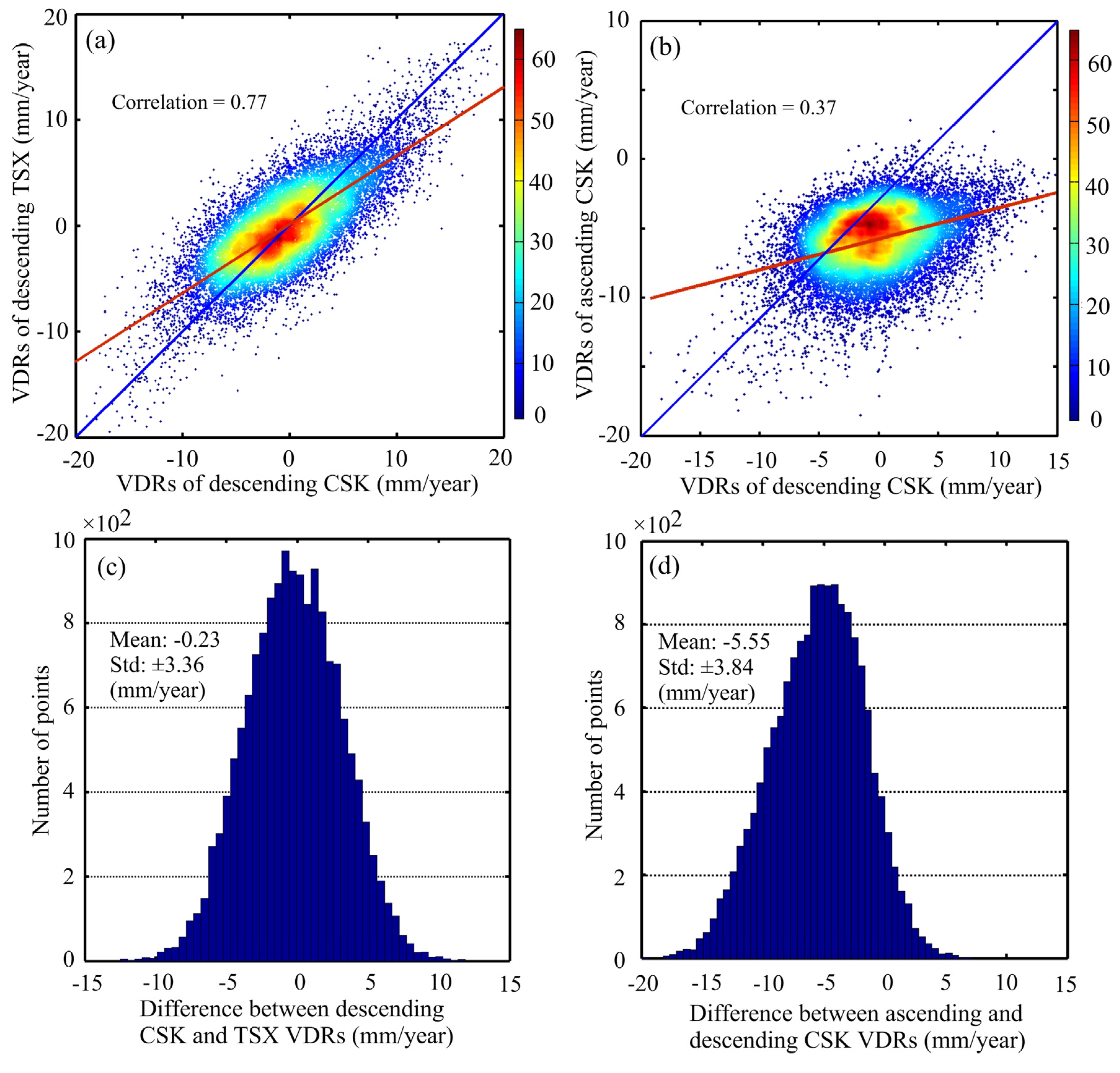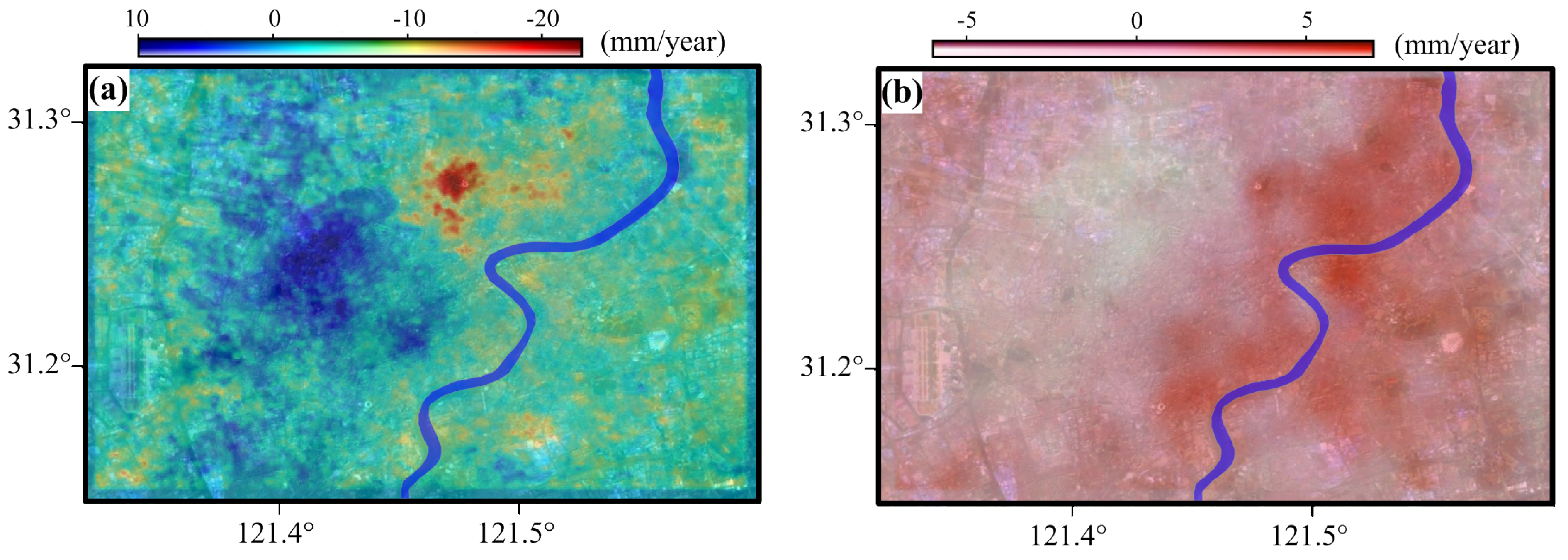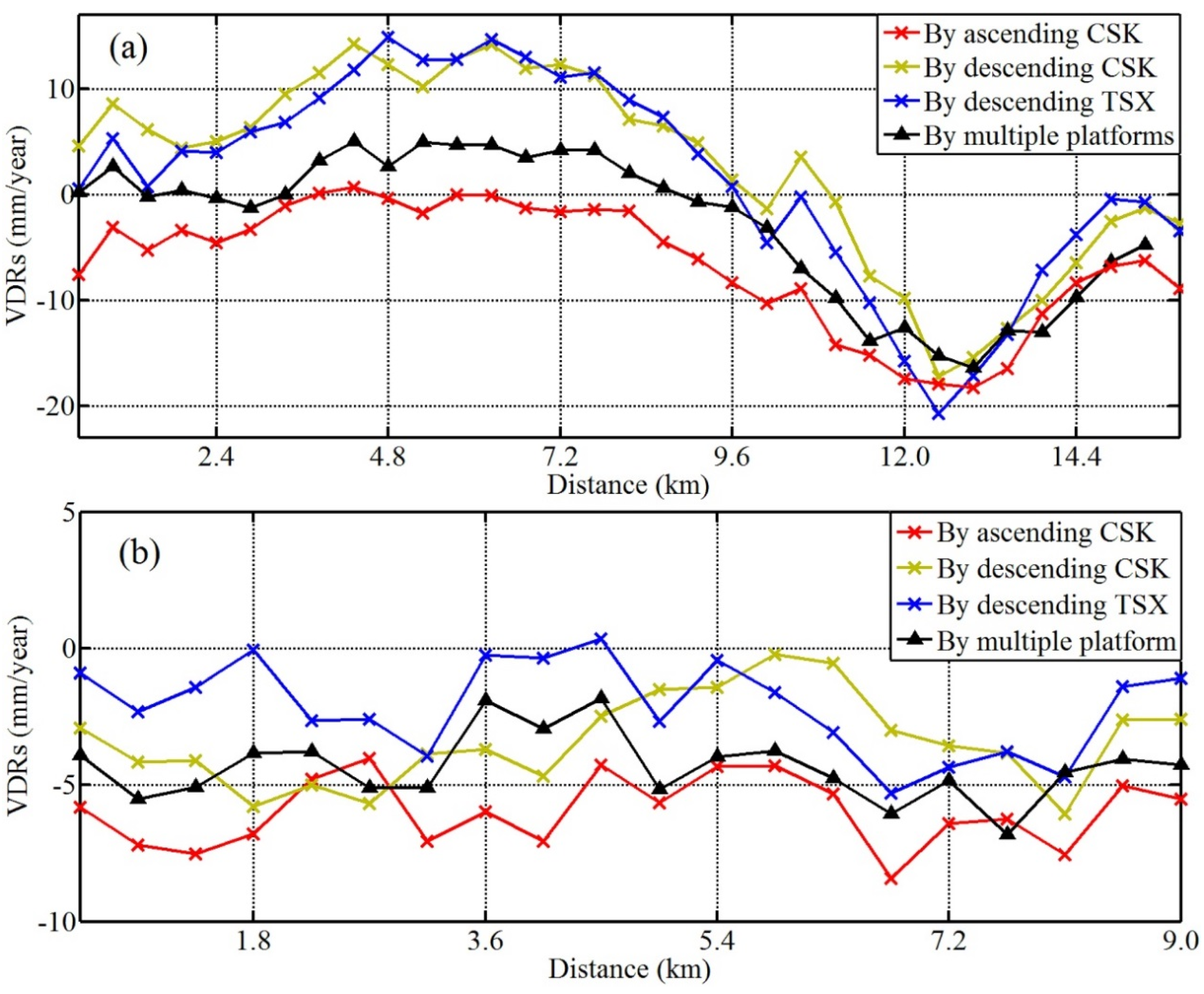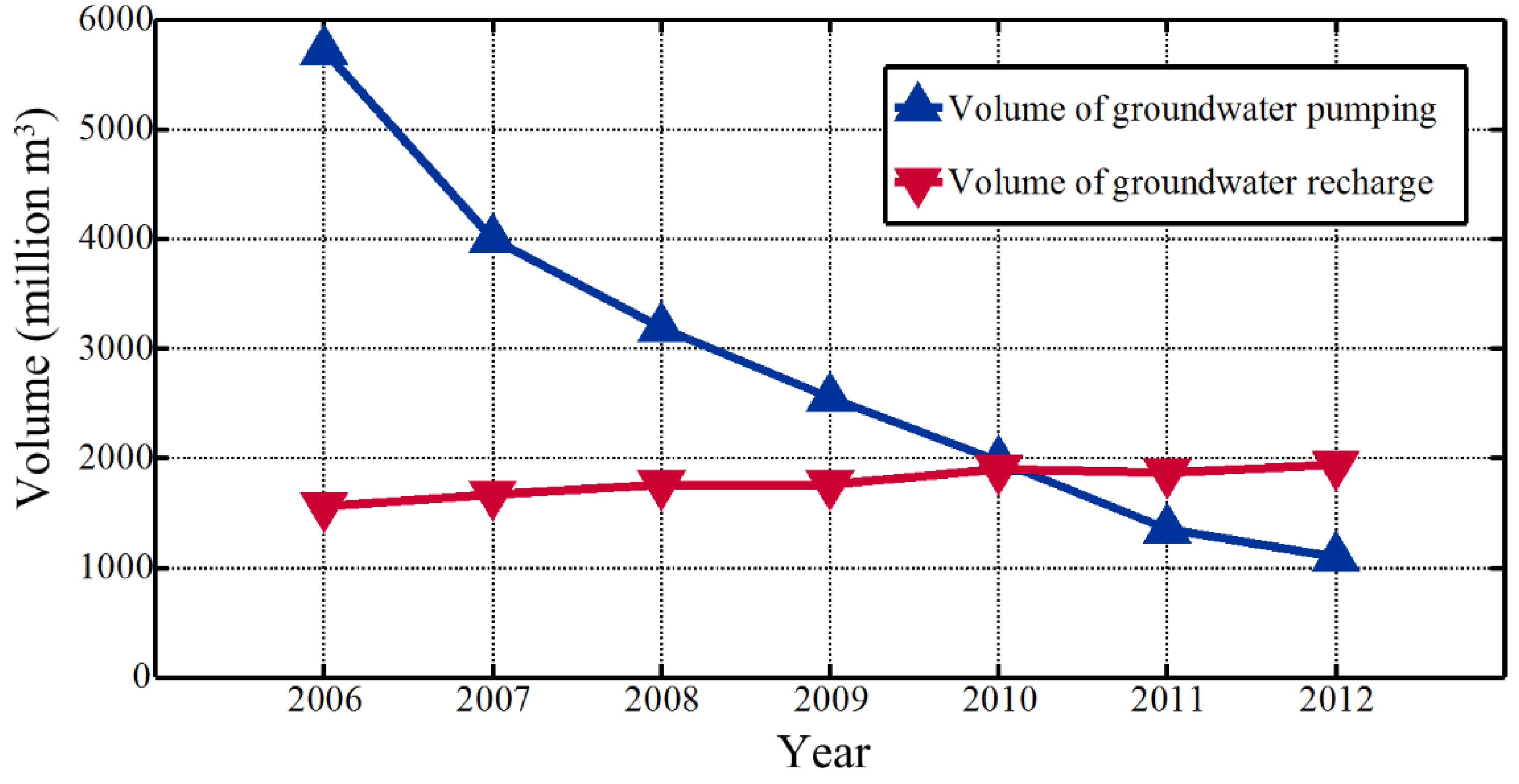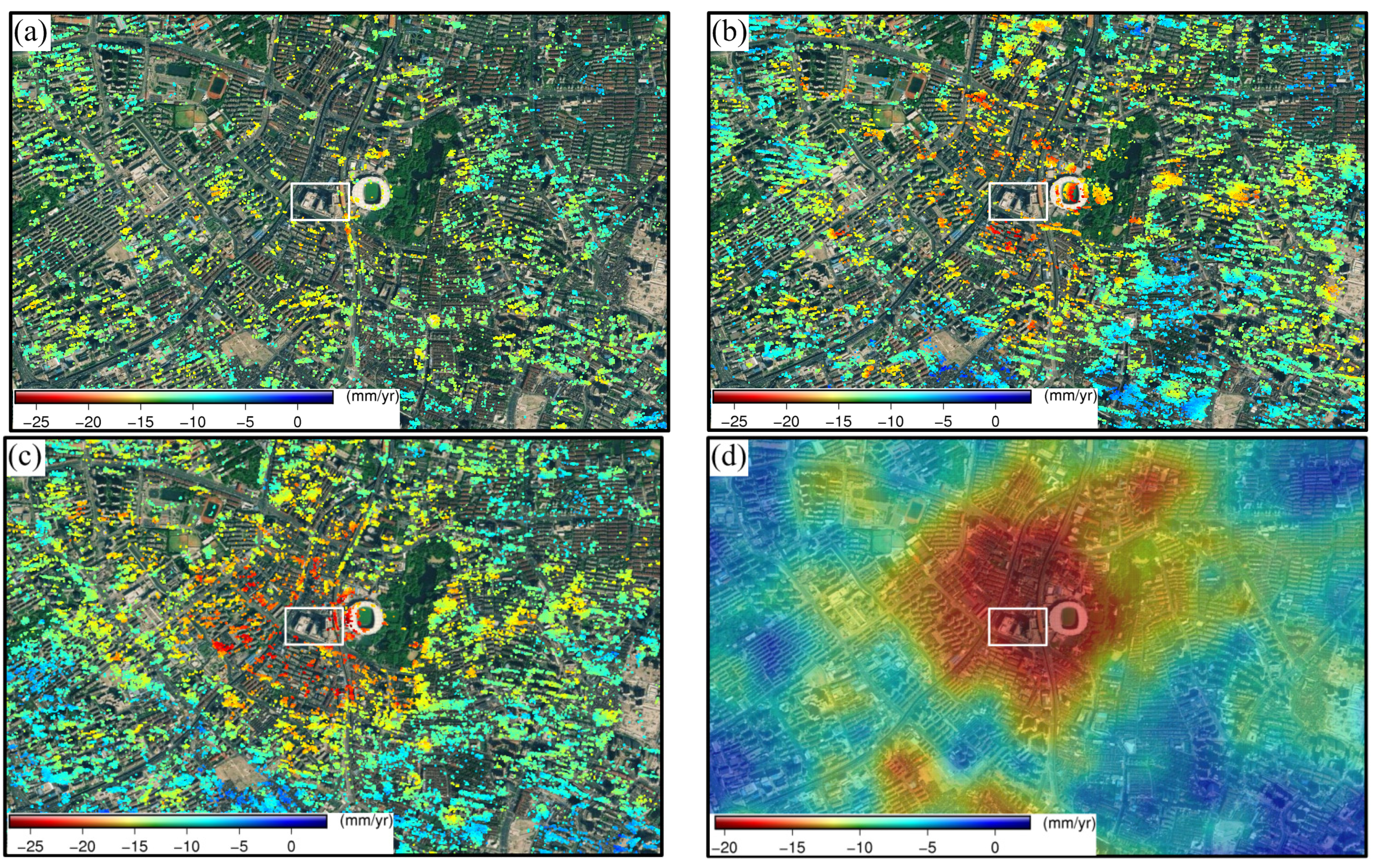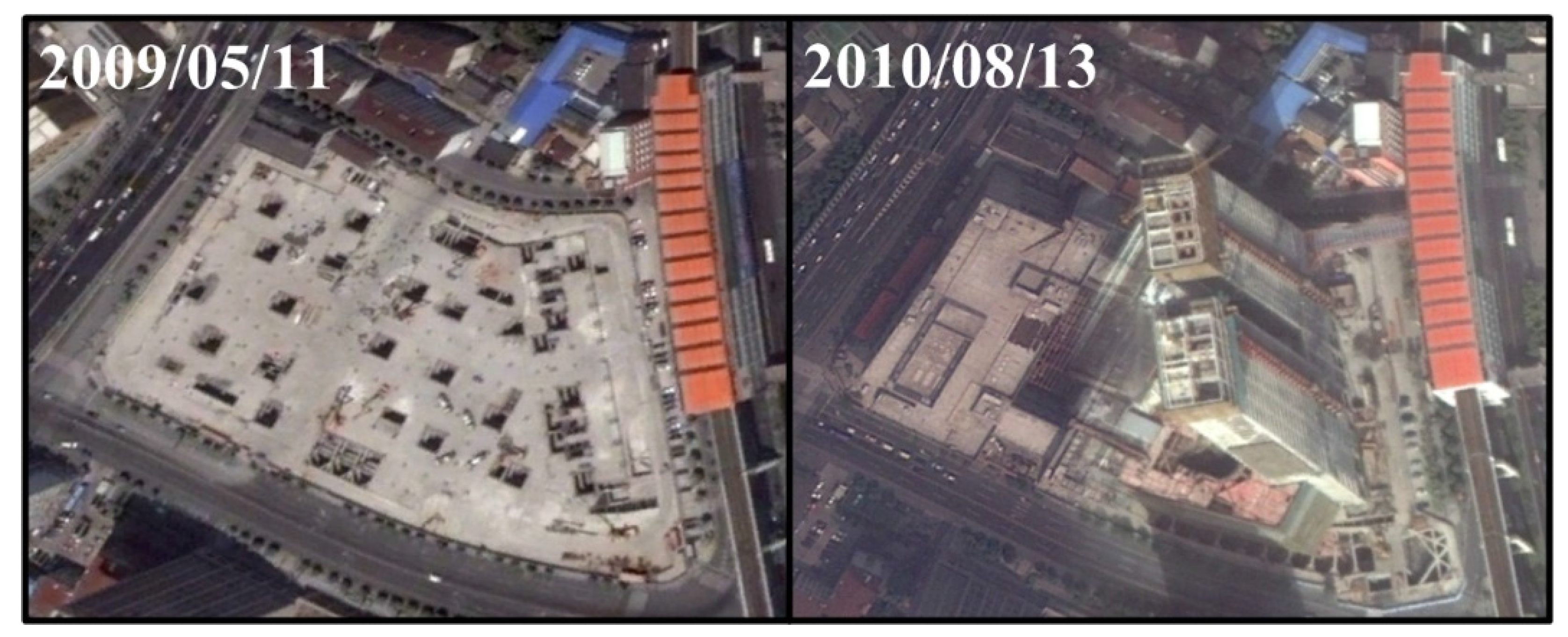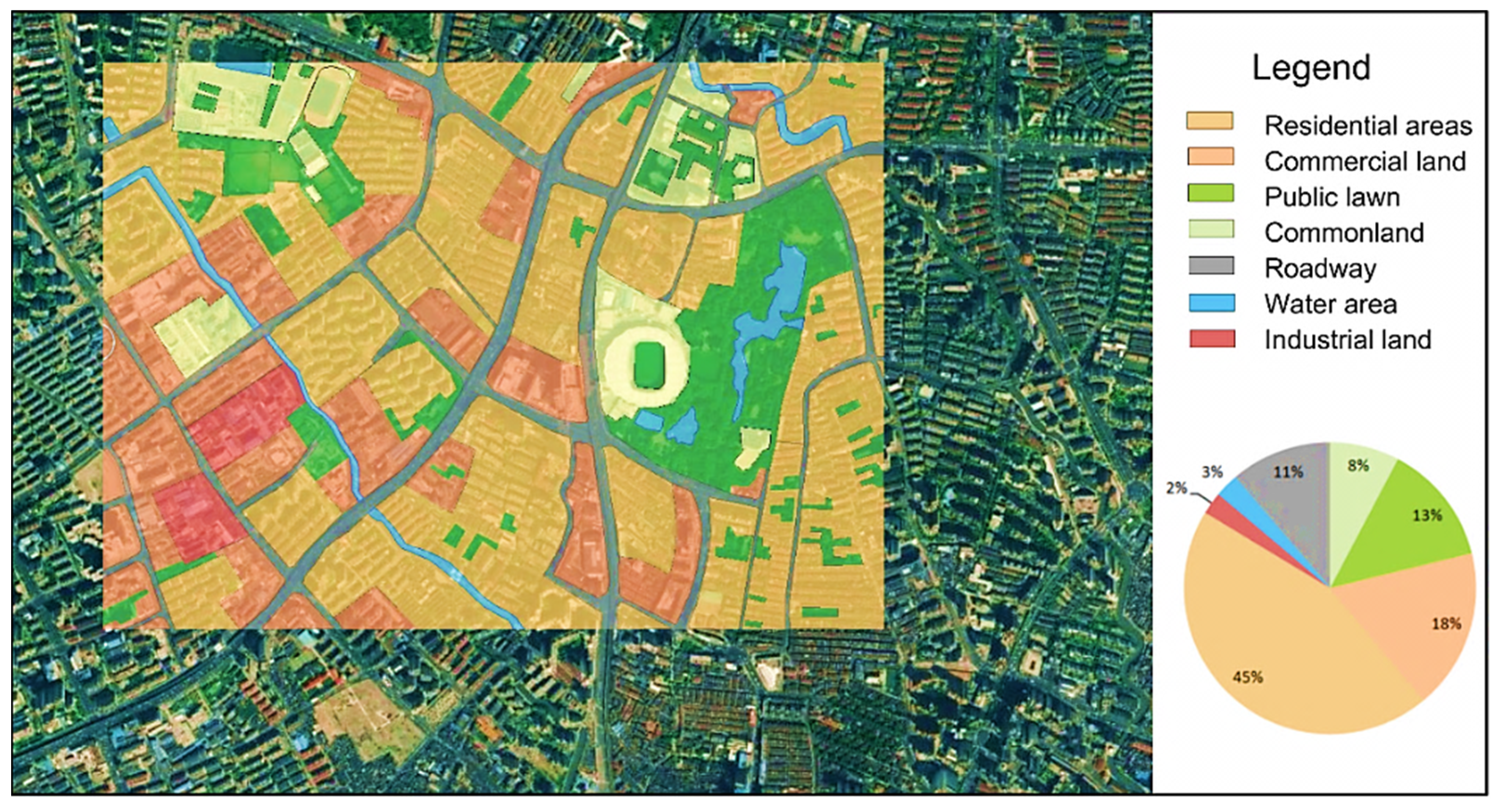4.1. The VDRs Derived by TCPInSAR
The LOS displacement rates at all the TCPs were first estimated using 13, 11, and 10 interferometric pairs for the three cases of ascending CSK, descending CSK, and descending TSX, respectively, by following the method described in
Section 2.1, thus deriving three types of LOS displacement rates for the study area. The VDRs at the TCPs were then calculated by dividing the LOS displacement rates by the cosine of the radar incidence angle.
Figure 4 shows the SAR amplitude image and the resultant VDRs in the study area derived through the TCPInSAR processing for the three cases of SAR images, exhibiting the similar distribution of VDRs.
Figure 4a shows the SAR amplitude image with annotation of the place names (
i.e., Hongkou District, Putuo District, Pudong District, and Changning District), three GPS sites (
i.e., TP20, XZ20, and BC17), the reference point for interferometric processing (indicated by a white star), a dashed rectangle, and two reference lines, which are used for later analysis. It should be noted that the VDRs are estimated using the reference point with zero motion.
Figure 4b–d show the VDRs derived for the three cases of ascending CSK, descending CSK, and descending TSX, respectively.
It can be observed from
Figure 4b–d that the VDRs range between −24 and 10, −26 and 23, and −27 and 22 mm/year for the ascending CSK, descending CSK, and descending TSX cases, respectively. The VDRs derived from the two types of descending datasets are in better agreement. A subsiding bowl appears around the Hongkou District, which will be further analyzed in
Section 4.3. A tendency of land uplifting appears in the middle of the maps, which is most likely ascribed to the efforts of groundwater recharge implemented by the Shanghai municipal government. Such results are in good agreement with those reported in previous studies [
12,
13,
25], thus indicating that the TCPInSAR method is viable for detecting land displacements around the urban and suburban areas without using an external DEM.
As a remark, it can be seen from
Figure 4b–d that the density of TCPs in the study area is very high for the three cases of SAR images. The statistical calculation shows that the density of TCPs reaches up to 3800, 4800, and 4900 per square kilometer for the ascending CSK, descending CSK, and descending TSX cases, respectively. The similar density of TCPs can be observed for the descending CSK and TSX cases, while the density of TCPs for the descending cases are about 1000 per square kilometer more than that for the ascending CSK case. This means that the different radar look directions play an important role for the density of TCPs in the study area with a number of high-rise buildings, but the different radar sensors have no apparent impact on the density of TCPs.
To further analyze the impacts of both the radar sensor and radar look direction on the VDRs, a comparison was performed between the VDRs derived from the descending CSK and descending TSX images, while the VDRs derived from the ascending and descending CSK images are mutually compared. The former comparison intends to reflect the discrepancy associated with the different radar sensor and the same-side radar look direction, while the latter comparison aims to reflect the discrepancy associated with the same radar sensor and the opposite radar look direction.
Figure 5 shows the two comparison cases.
Figure 5a,c show the correlation map and the difference histogram of the descending CSK against descending TSX VDRs, while
Figure 5b,d show the comparisons of the ascending against descending CSK VDRs.
The statistical calculation indicates that the mean and standard deviation of the differences between the descending CSK and TSX VDRs are −0.2 mm and ±3.4 mm/year, respectively, while those between the ascending and descending CSK VDRs are −5.6 mm and ±3.8 mm/year, respectively. The correlation coefficient between the descending CSK and TSX VDRs is 0.77, while that between the ascending and descending CSK VDRs is 0.37. It is clear that the VDRs derived from the same-side radar look directions are in obviously better agreement than those derived from the opposite radar look directions, although the different radar incidence angles also have an impact on the VDRs.
Figure 4.
The SAR amplitude image and the VDRs in the study area derived through the TCPInSAR processing. (a) shows the SAR amplitude image with annotation of the placenames (Hongkou District, Pudong New District, Putuo District, and Changning District), three GPS sites (TP20, XZ20, and BC17), the reference point for interferometric processing (indicated by a white star), a dashed rectangle and two reference lines, which are used for later analysis. The VDRs are shown in (b–d) for the ascending CSK, descending CSK, and descending TSX case, respectively.
Figure 4.
The SAR amplitude image and the VDRs in the study area derived through the TCPInSAR processing. (a) shows the SAR amplitude image with annotation of the placenames (Hongkou District, Pudong New District, Putuo District, and Changning District), three GPS sites (TP20, XZ20, and BC17), the reference point for interferometric processing (indicated by a white star), a dashed rectangle and two reference lines, which are used for later analysis. The VDRs are shown in (b–d) for the ascending CSK, descending CSK, and descending TSX case, respectively.
It should be realized that the validity of the simple conversion from the LOS to vertical displacement at a ground target can be guaranteed if and only if no horizontal motion takes place. Previous studies indicate that the study area is actually affected by the horizontal crustal movements due to the specific geological settings [
26,
27]. According to the global positing system (GPS) measurements derived from the China Crustal Movement Observation Network, the mean velocity of horizontal motion in the coastal region of Eastern China is about 20 mm/year towards southeast, and the uneven horizontal motions can be observed in the region [
26]. Moreover, the GPS results derived at the ITRF2000 reference station SHAO (see
Figure 2) in Shanghai indicate that its eastward and northward velocity is 32 and 16 mm/year, respectively. It means that the land around Shanghai is moving east-southeastward with respect to the stable Eurasia [
27]. Further analysis with the GPS data at other sites shows that the velocity of horizontal motion varies spatially in the study area of Shanghai (see
Section 4.2). The aforementioned comparisons show that the radar look directions (
i.e., same-side and opposite) have a significant impact on the results of VDRs. If no uneven horizontal motion occurs in the study area, the VDRs derived from the three cases of SAR images should be in very good agreement. It can be concluded that the uneven horizontal motion in the study area cannot be ignored and the VDRs shown in
Figure 4 should be further improved.
Figure 5.
The comparison between the VDRs derived from the different cases of SAR images (a–d). (a,c) show the scatterplot and the difference histogram, respectively, of the descending CSK against descending TSX VDRs, while (b,d) show the comparisons of the ascending against descending CSK VDRs. The red lines and the colorbar in (a,b) are the best-fit lines and the frequency number of VDRs.
Figure 5.
The comparison between the VDRs derived from the different cases of SAR images (a–d). (a,c) show the scatterplot and the difference histogram, respectively, of the descending CSK against descending TSX VDRs, while (b,d) show the comparisons of the ascending against descending CSK VDRs. The red lines and the colorbar in (a,b) are the best-fit lines and the frequency number of VDRs.
4.2. The Improved VDRs and Cross Validation
We further improved the VDRs by following the localized LS solution method as presented in
Section 2.2. The LOS displacement rates were first extracted for the study area (marked in
Figure 2) for the ascending CSK, descending CSK, and descending TSX case, respectively, thus deriving the three types of LOS displacement rates at the same grid points as the input of the localized LS solution. For the convenience of further processing, the Kriging interpolation [
28] was first performed at all the grid points with missing data for each type of LOS displacement rates. Considering the angular parameters listed in
Table 1, the transform Equation (11) for the LS solution can be rewritten by:
The localized LS method (see
Section 2.2) based on a moving window with a size of about 1.5 km ×1.5 km was then applied to estimate the improved VDRs and HDRs on a point-by-point basis. The VDRs and HDRs at the center point of the window were resolved by the LS solution with use of the three types of LOS displacement rates in the window.
Figure 6a shows the distribution of the resultant VDRs in the study area derived by the localized LS method based on the multi-platform SAR images. It can be observed from
Figure 6a that the improved VDRs range between −23 and 10 mm/year in the study area.
Figure 6.
The maps of the resultant VDRs (a) and the relative E–W displacement rates (b) in the study area derived by the localized LS method based on the multi-platform SAR images.
Figure 6.
The maps of the resultant VDRs (a) and the relative E–W displacement rates (b) in the study area derived by the localized LS method based on the multi-platform SAR images.
As a by-product,
Figure 6b shows the map of E-W displacement rates in the study area with reference to the GPS site XZ02 (see
Figure 4a). As the relative N-S motion magnitude is smaller in the study area (also indicating by the GPS results at the ITRF2000 reference station SHAO) and that InSAR is not very sensitive to the N-S motion, the relative N-S displacement rates are not presented here. It can be seen from
Figure 6b that the relative E-W displacement rates range between −7.2 and 6.2 mm/year. The pattern in
Figure 6b indicates that E-W motion is not consistent in the entire study area. The magnitude of E-W displacement rates in the left part of the study area is smaller than that in the right part. The relative E-W displacement rates derived by our study at the GPS sites TP20 and BC17 (see
Figure 4a) are −1.8 and 2.9 mm/year, respectively, which are comparable with those (−2.2 and 4.4 mm/year) derived from the GPS measurements by Cai
et al. [
27]. Obviously, such numerical comparison shows that uneven horizontal motions have taken place in the study area, although the GPS results were derived in advance (about four years) than the InSAR results. This also indicates that our localized LS method based on the multi-platform SAR images can be applied to efficiently improve the VDRs in the study area.
Figure 7.
The comparisons of the profiles of VDRs derived from processing of the single- and multi-platform SAR images along the lines AA′ (a); and BB′ (b).
Figure 7.
The comparisons of the profiles of VDRs derived from processing of the single- and multi-platform SAR images along the lines AA′ (a); and BB′ (b).
To compare the VDRs derived from the single- and multi-platform SAR images,
Figure 7 shows the examples of two profiles of VDRs extracted along the lines AA′ and BB′ (see
Figure 4a) from the results as shown in
Figure 4b–d and
Figure 6. It is clear that the variation trend of VDRs along either AA′ or BB′ is very similar among the four types of results derived from the multi-platform, ascending CSK, descending CSK and descending TSX data. The four types of VDRs along AA′ across the subsiding bowl around the Hongkou District and the Changning District range between −20 and 13 mm/year, while those along BB′ across the Pudong New District range between −7 and 2 mm/year. However, the profile of VDRs derived from the multi-platform data is located in the middle of the profiles of VDRs derived from the three types of single-platform data.
It should be noted that the profile of VDRs along either AA′ or BB′ derived from the descending CSK data is generally closer to that derived from the descending TSX data, while the profile derived from the ascending CSK data is apparently not consistent with those derived from the descending CSK and TSX data. Such discrepancy can be ascribed to the uneven eastward horizontal motion in the study area, which may result in the biased VDR (see
Figure 1). In the ascending case, the eastward motion can cancel out a portion of uplifting magnitude in the uplifting area (see the left section of
Figure 7a) and provide the additional but erroneous subsiding magnitude in the subsiding area (
Figure 7b), thus resulting in the smaller and larger vertical displacement magnitude (biased), respectively. In the descending case, the eastward motion can provide the additional but erroneous uplifting magnitude in the uplifting area and cancel out a portion of subsiding magnitude in the subsiding area, thus resulting in the larger and smaller vertical displacement magnitude (biased), respectively. This indicates once again that the horizontal motion in the study area cannot be ignored, and the simple method of converting from the LOS to vertical displacement cannot be accepted for a study area with even minor horizontal motion. It can be concluded that the VDRs derived by the TCPInSAR-LS solution with the multi-platform data are more accurate than those derived only by the TCPInSAR solution with the single-platform data.
4.3. Analysis and Discussion
The existing studies indicated that the groundwater pumping and the high-rise buildings are the two main reasons for land sinking in shanghai [
29,
30]. Xu
et al. [
31] reported that the Quaternary deposit of about 300 m in Shanghai is composed of an alternated multi-aquifer-aquitard system, and the groundwater system is composed of the five aquifer layers and the five aquitard layers. Most areas of Shanghai are covered by loose and soft soil, thus leading to plenty of groundwater resource. With the rapid urban expansion in Shanghai, the groundwater pumping cannot be stopped completely in some localized areas, thus still resulting in land subsidence, although the Shanghai municipal government has taken some control measures to mitigate land subsidence, for example, reducing groundwater extraction and increasing groundwater recharge. Due to the groundwater pumping and the overload related to the high-rise buildings in Shanghai, the water releases from the pores in soil and the valid pressure becomes larger [
30], thus leading to decline of the groundwater level, compression of the loose soil and land sinking.
Figure 6a exhibits that the Pudong New District in Shanghai (the right-hand side in
Figure 6a) is of a relatively stable region with a minor sinking or uplifting trend, which is a newly-developed district (establishing since 1995) with a long-term ecological development strategy. However, a subsiding bowl appears in the Hongkou District, and will be further analyzed later. Moreover, a large uplifting part with an area of about 70 km
2 appears in the west downtown of Shanghai,
i.e., at the south of the Putuo District and the north of the Changning District. Such an uplifting trend can be ascribed to the two control measures implemented by the Shanghai municipal government,
i.e., decreasing the groundwater pumping volume and increasing the groundwater recharge volume. According to the Shanghai Water Resource Bulletin [
32],
Figure 8 shows the total volume of groundwater pumping and recharge fulfilled in Shanghai for every year in the period of 2006–2012. It can be seen that the volume of groundwater pumping and recharge in Shanghai was dramatically decreased and gradually increased, respectively, in the six years. In 2010, the volume of groundwater pumping and recharge almost reached to the same magnitude (about 2000 million·m
3). Before 2010, the volume of groundwater pumping was larger than the volume of groundwater recharge. After 2010, the volume of groundwater recharge started to exceed the volume of groundwater pumping. Such data analysis can reasonably explain the land uplifting trend at the west downtown of Shanghai and the land stableness in the Pudong New District.
The further analysis concentrates on an area of about 3 km
2 (marked by a dashed rectangle in
Figure 4a) located in the Hongkou District, which is identified as a subsiding bowl.
Figure 9 displays the enlarged maps of VDRs (superimposed onto the high-resolution optical image obtained from Google Earth) around the subsiding bowl derived from the single- and multi-platform SAR images.
Figure 9a–c show the maps of VDRs at all the TCPs derived through the TCPInSAR processing for the three cases of single-platform SAR images acquired by the ascending CSK, descending CSK, and descending TSX, respectively.
Figure 9d shows the map of improved VDRs derived through the localized LS method based on the multi-platform SAR images. It can be seen that from
Figure 9a–d, land subsidence has taken place in the localized area. The VDRs obtained from the single-platform SAR images range between −24 and 1, −26 and 4, and −27 and 3 mm/year for the ascending CSK, descending CSK, and descending TSX case, respectively, while the VDRs obtained from the multi-platform SAR images range between −23 and 0 mm/year.
A careful inspection with
Figure 9a–c indicates that the TCPs are primarily distributed over the roofs of buildings and the subsiding bowl center corresponds to the Hongkou Stadium of Shanghai. It is very interesting that the localized part (marked by a rectangle in
Figure 9) around the subsiding bowl center possess the sparse TCPs, thus indicating that the temporal radar decorrelation occurred in this part. According to our detailed investigation, this part was under construction during the acquisition of CSK and TSX images used in this study. This can be verified by the two enlarged optical image patches as shown in
Figure 10, which were acquired on 11 March 2009 and 12 August 2010, respectively. It shows that the building construction was ongoing. The TCPs were therefore sparse in this part due to the temporal radar decorrelation associated with the surface alteration. As few TCPs are available around the subsiding bowl, the VDRs obtained by interpolation in the localized area have limited reliability and accuracy.
Figure 8.
The groundwater pumping and recharge volume fulfilled in Shanghai for every year in the period of 2006–2012. The data are obtained from the Shanghai Water Resource Bulletin [
32].
Figure 8.
The groundwater pumping and recharge volume fulfilled in Shanghai for every year in the period of 2006–2012. The data are obtained from the Shanghai Water Resource Bulletin [
32].
Figure 9.
The enlarged maps of VDRs around the subsiding bowl derived from the single- and multi-platform SAR images, which are superimposed onto the high-resolution optical image obtained from Google Earth. (a–c) show the maps of VDRs at all the TCPs derived through the TCPInSAR processing for the three cases of single-platform SAR images acquired by the ascending CSK, descending CSK, and descending TSX, respectively; (d) shows the map of improved VDRs derived through the localized LS method with use of the multi-platform SAR images.
Figure 9.
The enlarged maps of VDRs around the subsiding bowl derived from the single- and multi-platform SAR images, which are superimposed onto the high-resolution optical image obtained from Google Earth. (a–c) show the maps of VDRs at all the TCPs derived through the TCPInSAR processing for the three cases of single-platform SAR images acquired by the ascending CSK, descending CSK, and descending TSX, respectively; (d) shows the map of improved VDRs derived through the localized LS method with use of the multi-platform SAR images.
Figure 10.
The two high-resolution optical image patches acquired on 11 May 2009 and 13 August 2010, respectively, over the area indicated by the rectangle in
Figure 9. The image patches are obtained from Google Earth.
Figure 10.
The two high-resolution optical image patches acquired on 11 May 2009 and 13 August 2010, respectively, over the area indicated by the rectangle in
Figure 9. The image patches are obtained from Google Earth.
To explore the impact factors, we generated a map (see
Figure 11) of land use classification in an area of 3.5 km
2 around the subsiding bowl based on the optical image and the field investigation. The numerical calculation on the areas occupied by the different types of objects indicates that the residential and commercial parts accounts for 63%, the public lawn (Luxun Park) for 13%, and the industrial land for 2%. According to Wei
et al. [
33], the land subsidence is highly related to the building space ratio (BSR,
i.e., a ratio between the total-building area and the land use area). If the BSR is bigger than 1.5, the land subsidence rate is usually higher than 20 mm/year [
33]. The area as shown in
Figure 11 has a high BSR (63% for residential and commercial land use in total). Apart from the factor of groundwater extraction, the dense population and the building overload may cause the land sinking. This implies that the BSR should be actually taken into account in the future urban planning in Shanghai.
Figure 11.
The map of land use classification in an area of 3.5 km2 around the subsiding bowl.
Figure 11.
The map of land use classification in an area of 3.5 km2 around the subsiding bowl.
